
Genus Cervus
Cervus is a genus of deer that primarily are native to Eurasia, although one species occurs in northern Africa and another in North America. In addition to the species presently placed in this genus, it has included a whole range of other species now commonly placed in other genera. Additionally, the species-level taxonomy is in a state of flux.
Roosevelt Elk (Cervus canadensis roosevelti)
The Roosevelt elk (Cervus canadensis roosevelti), also known commonly as the Olympic elk and Roosevelt's wapiti, is the largest of the four surviving subspecies of elk (Cervus canadensis) in North America by body mass (although by antler size, both the Boone and Crockett (rifle) and Pope and Young (bow) records have Rocky Mountain elk being larger; none of the top 10 Roosevelt elk would score in the top 20 of Pope and Young's Rocky Mountain elk. In both species, mature bulls weigh from 700 to 1200 lbs. with very rare large bulls weighing more.) Its geographic range includes temperate rainforests of the Pacific Northwest, extending to parts of northern California. It was introduced to Alaska's Afognak, Kodiak, and Raspberry Islands in 1928 and reintroduced to British Columbia's Sunshine Coast from Vancouver Island in 1986.
In December 1897, mammalogist C. Hart Merriam named the species after his friend Theodore Roosevelt, then Assistant Secretary of the US Navy.[8]: 589 The desire to protect the Roosevelt elk was one of the primary forces behind the establishment of the Mount Olympus National Monument in 1909 by President Theodore Roosevelt. Later in 1937, President Franklin D. Roosevelt visited the region and saw the elk named after his relative. The following year he created Olympic National Park.
Roosevelt Elk (Cervus canadensis roosevelti) - Prairie Creek Herd Northern California
















































Roosevelt Elk (Cervus canadensis roosevelti) - Olympic Peninsula, Hoh River Herd & Sequim Herd
Map of OLYM (green boundary) and surrounding areas of the Olympic Peninsula, showing the approximate distributions of elk that use OLYM all year (park resident herds) or some part of the year. Red shading suggests the approximate annual ranges of park elk herds that migrate seasonally between distinctive summer and winter / spring ranges. Yellow suggests approximate annual ranges of migratory herds that summer in the park and winter outside the park in eastern valleys. Blue suggests approximate annual ranges of non-migratory elk herds that reside year-round in the park in low-elevation western rainforest valleys. Purple suggests approximate annual ranges of non-migratory herds that have annual ranges partly inside the park, and partly outside the park. The annual ranges of many herds may overlap, and this map does not show the ranges of all elk herds on the Olympic Peninsula.










































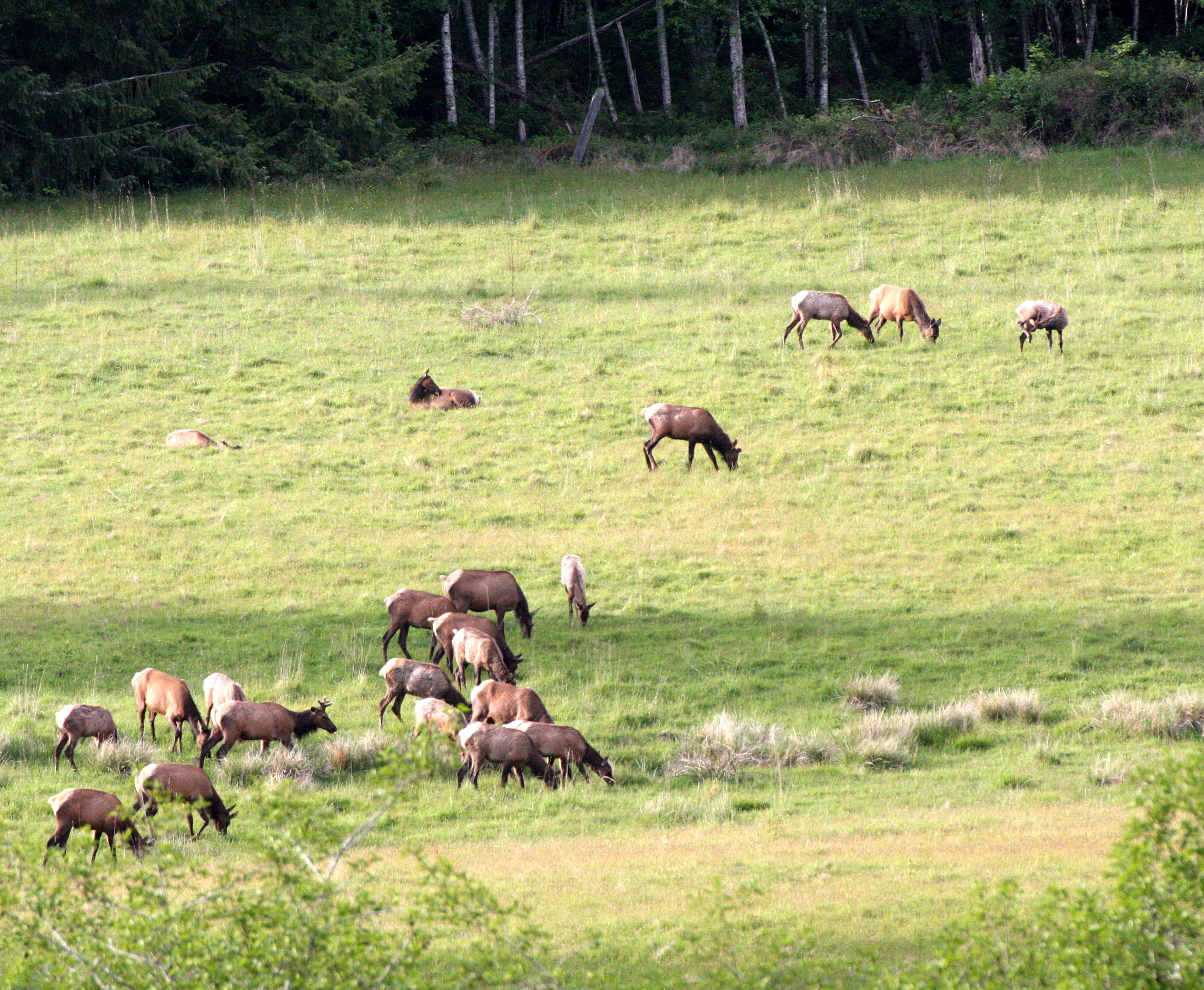














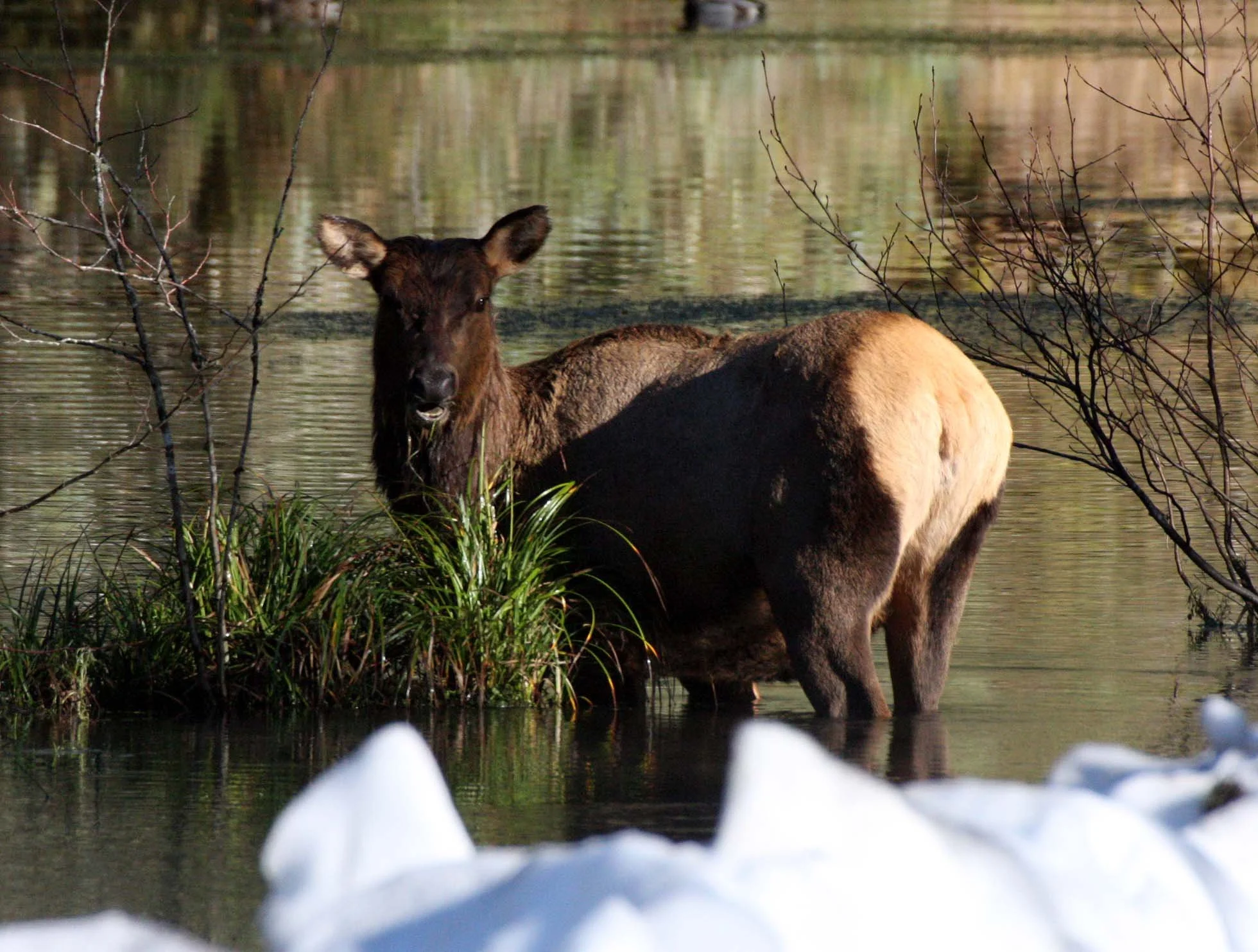





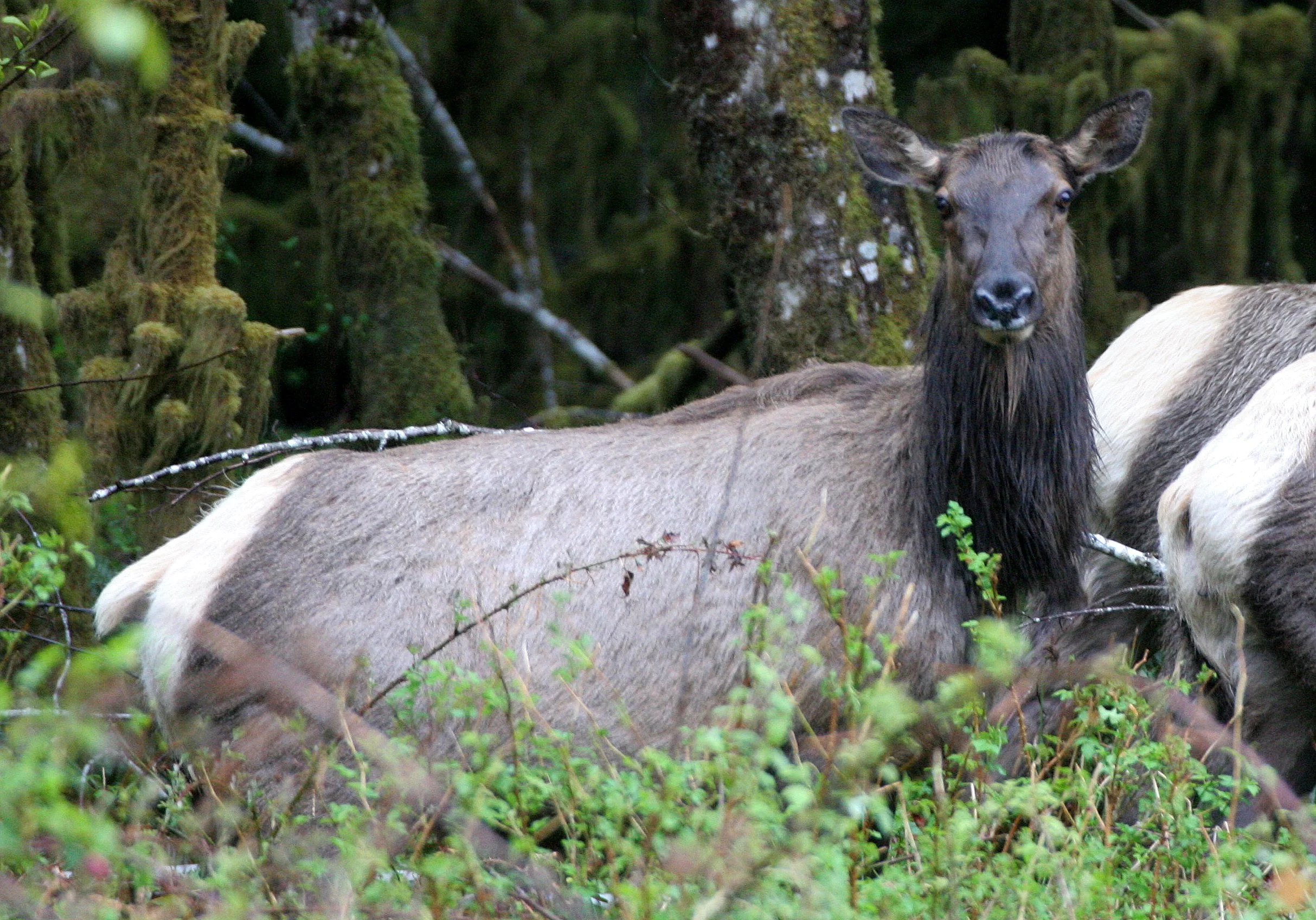











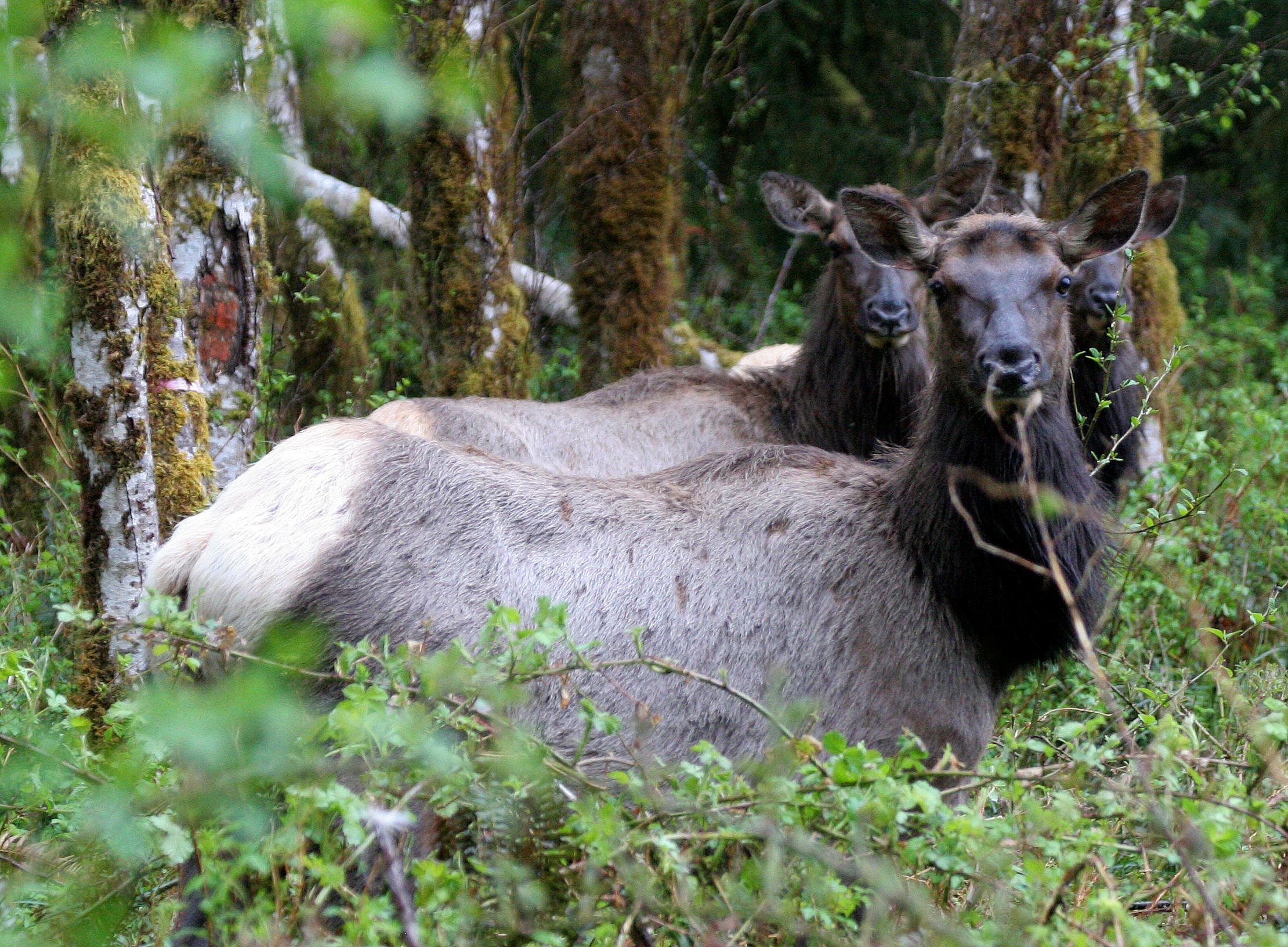








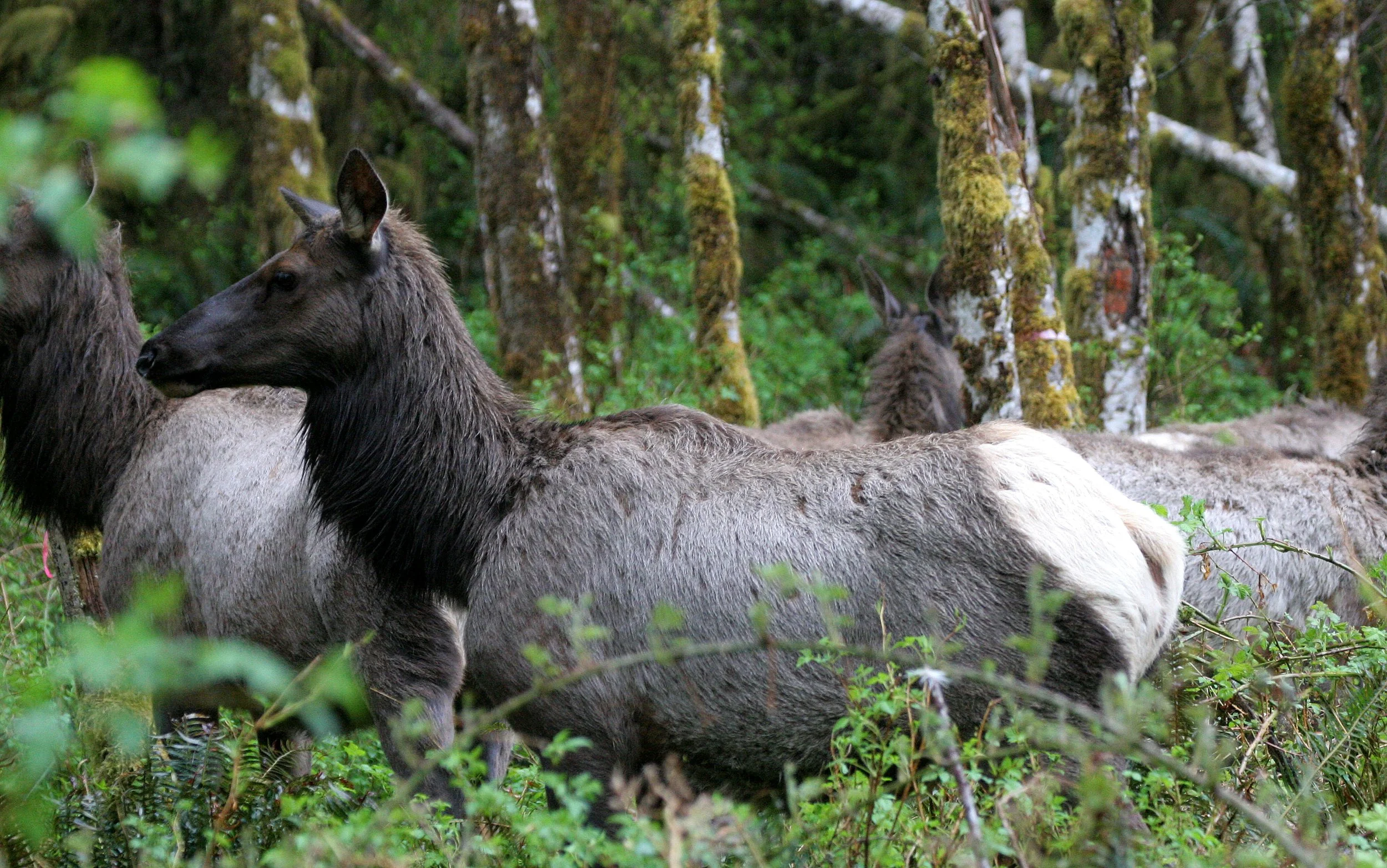


















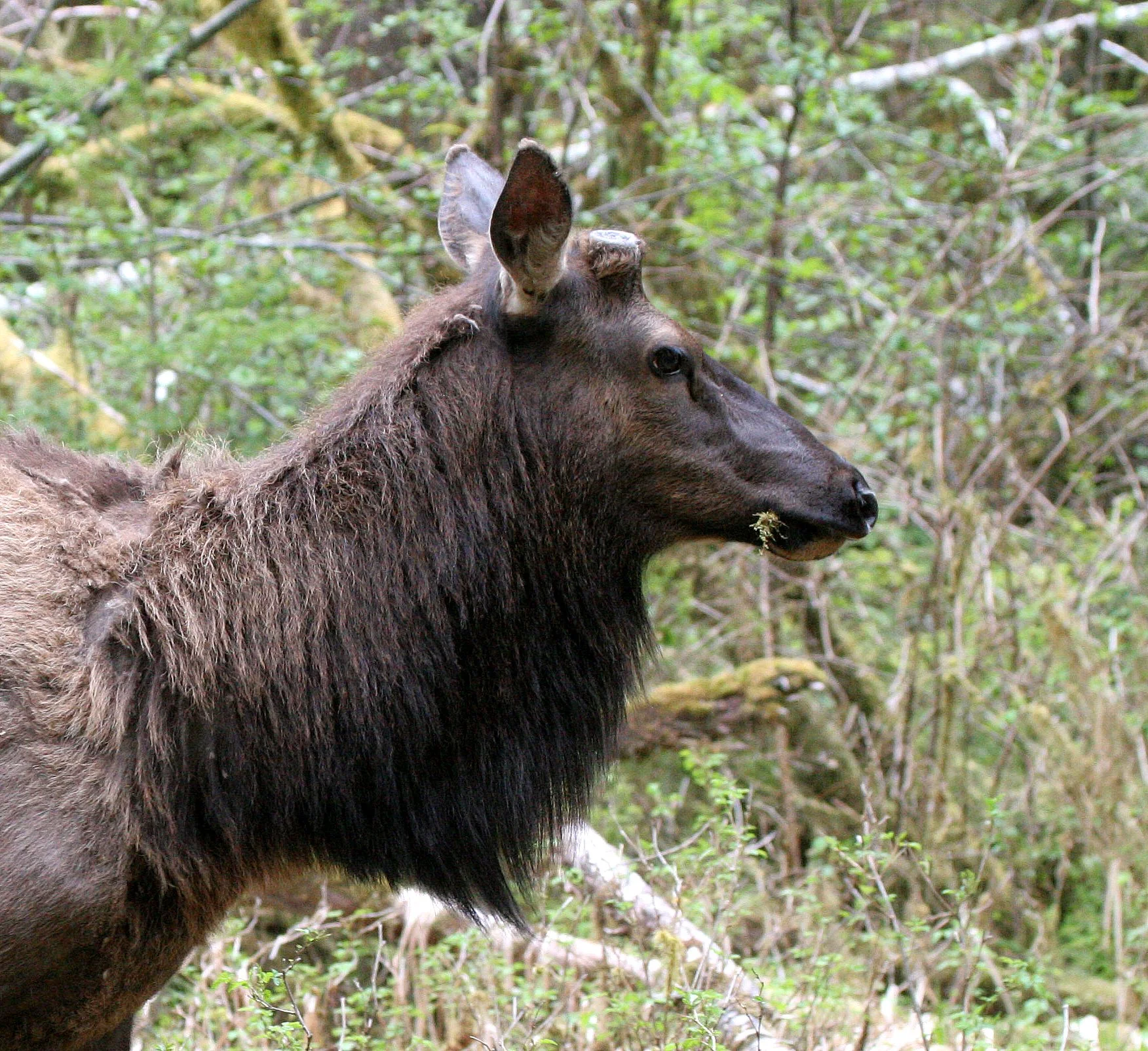











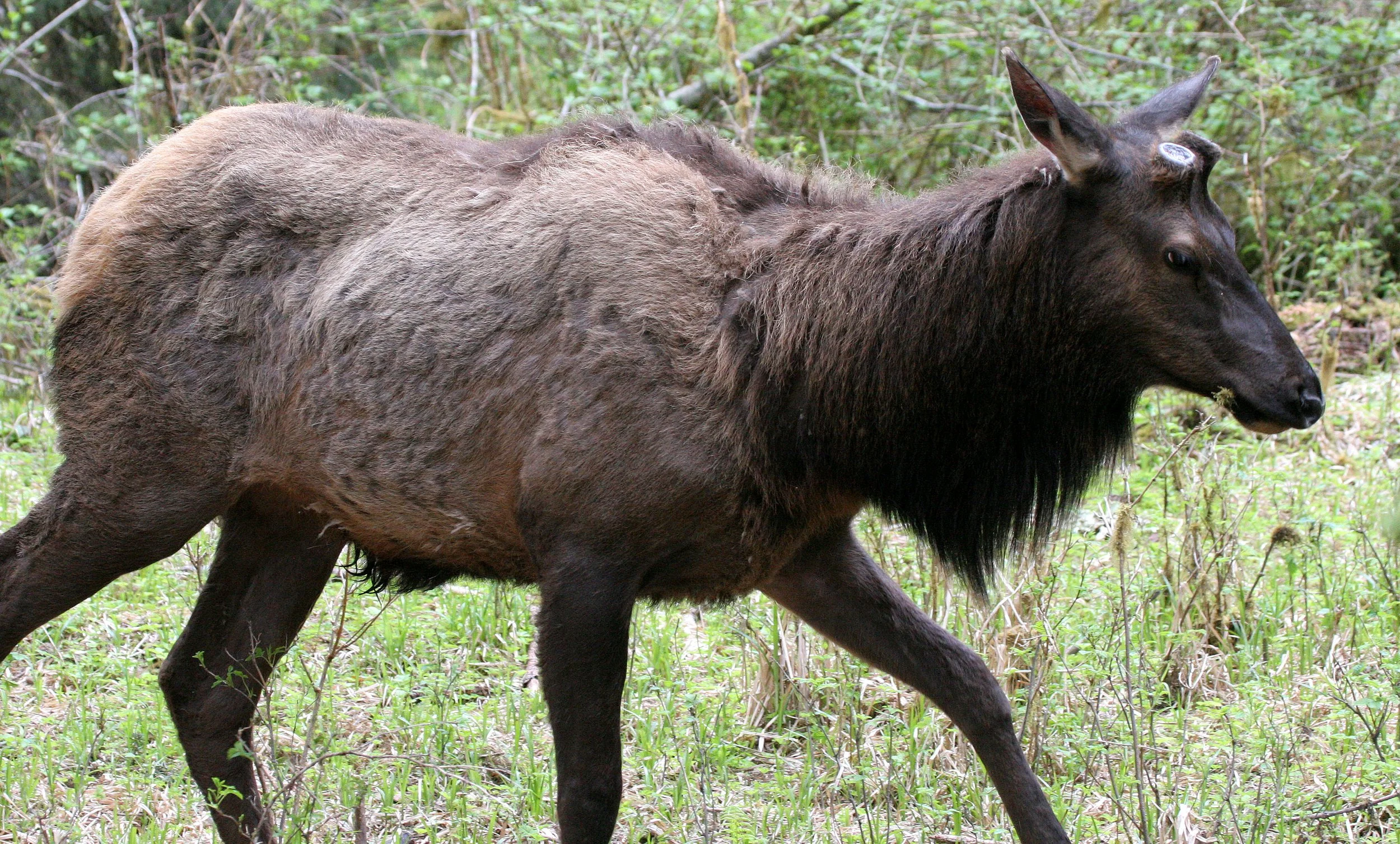
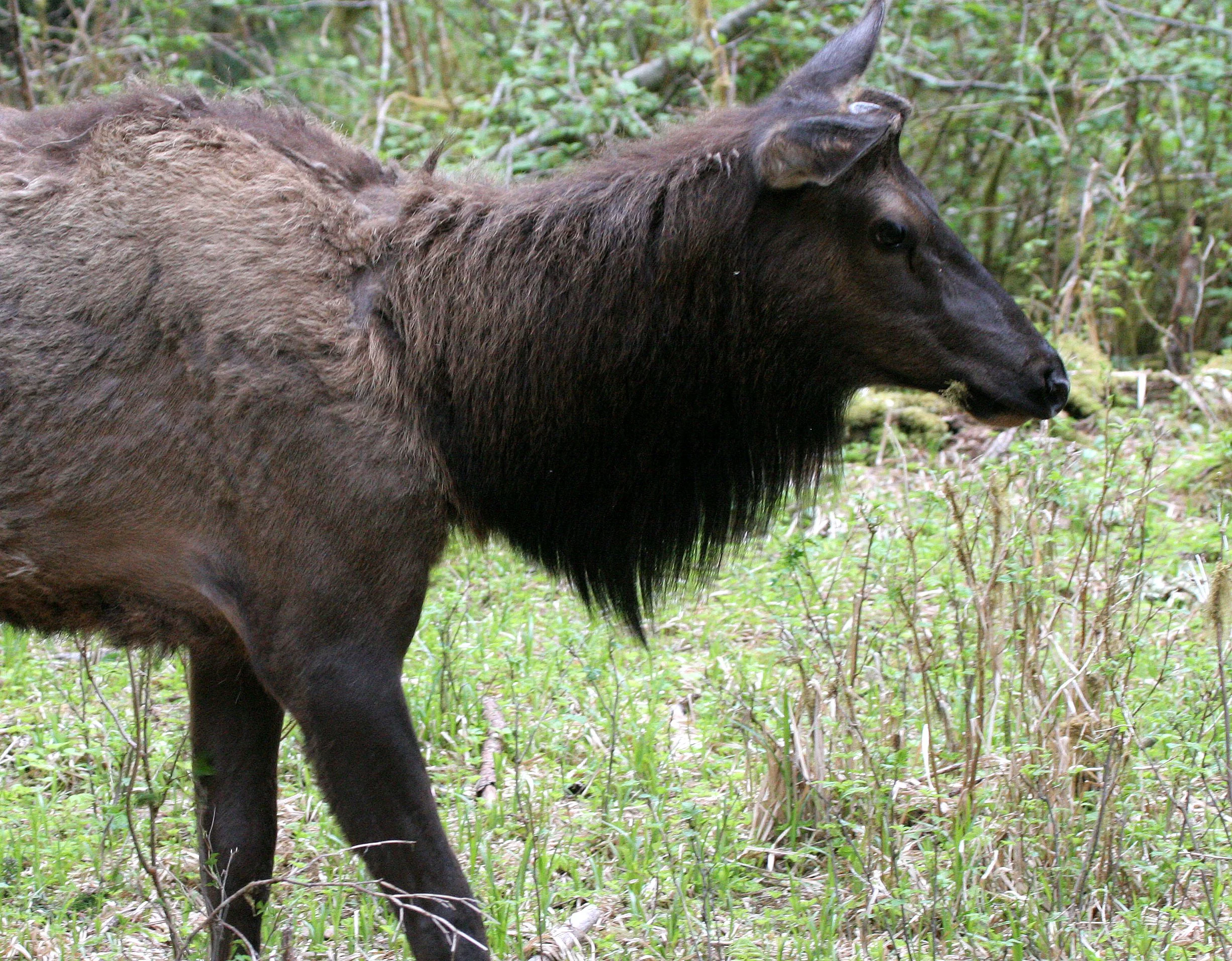




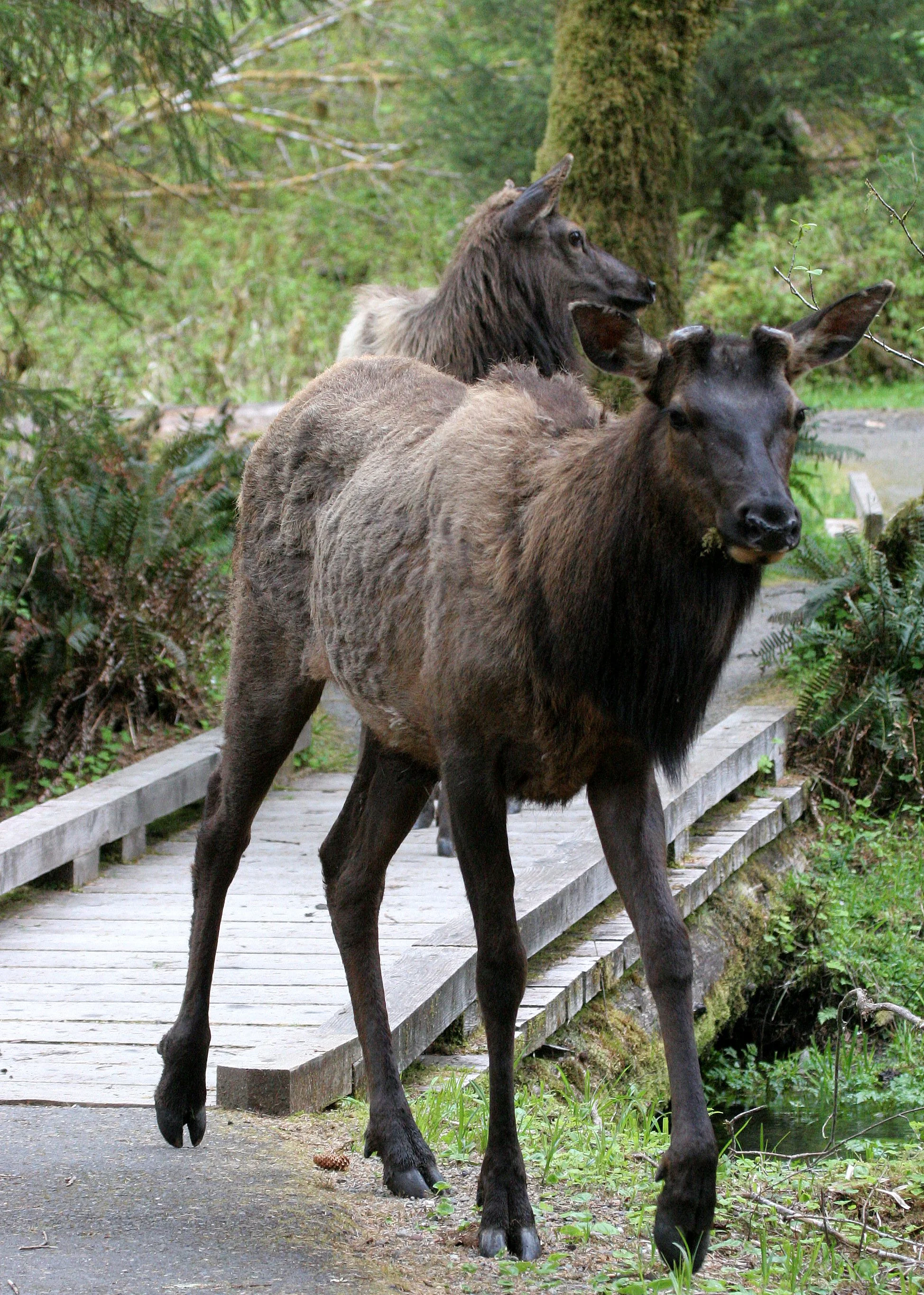












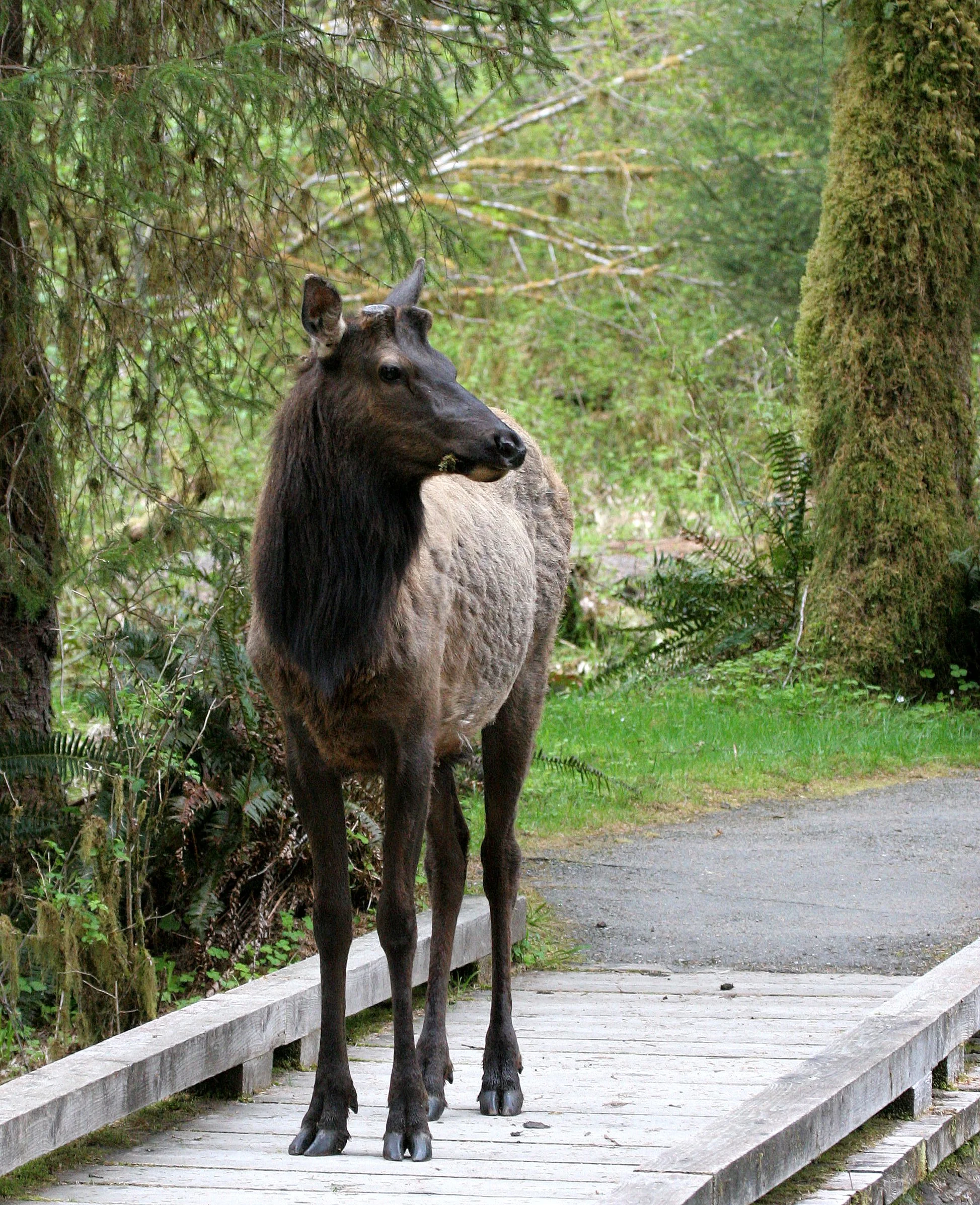
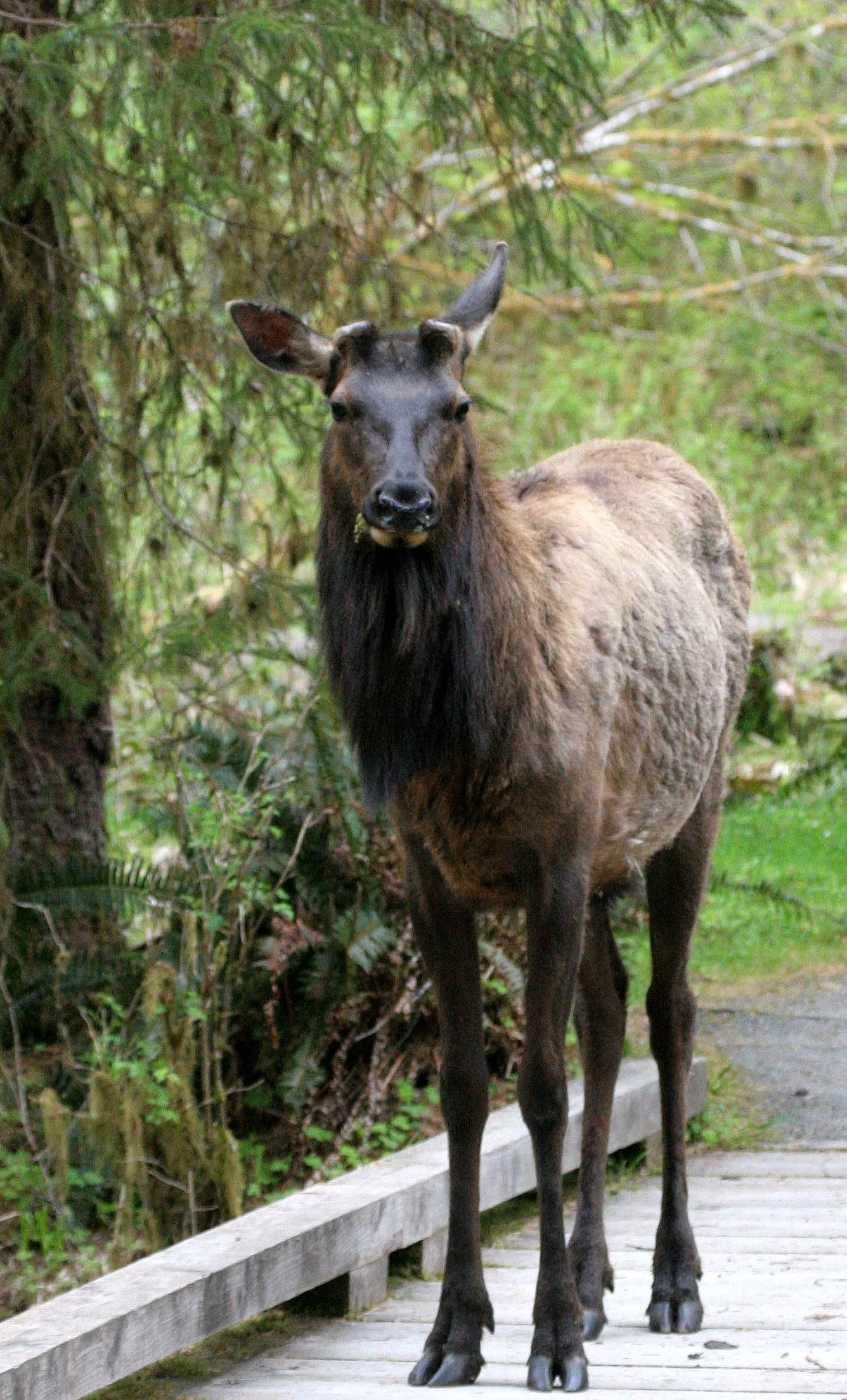






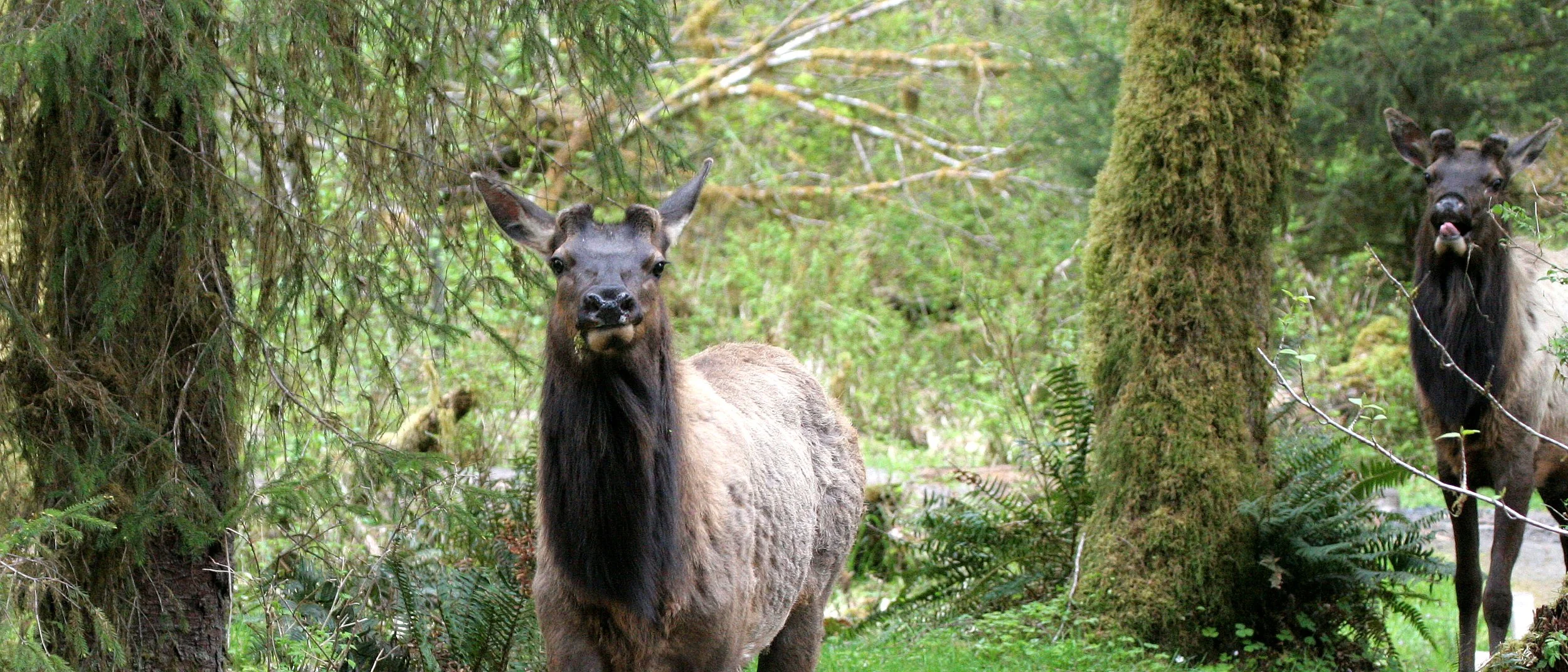

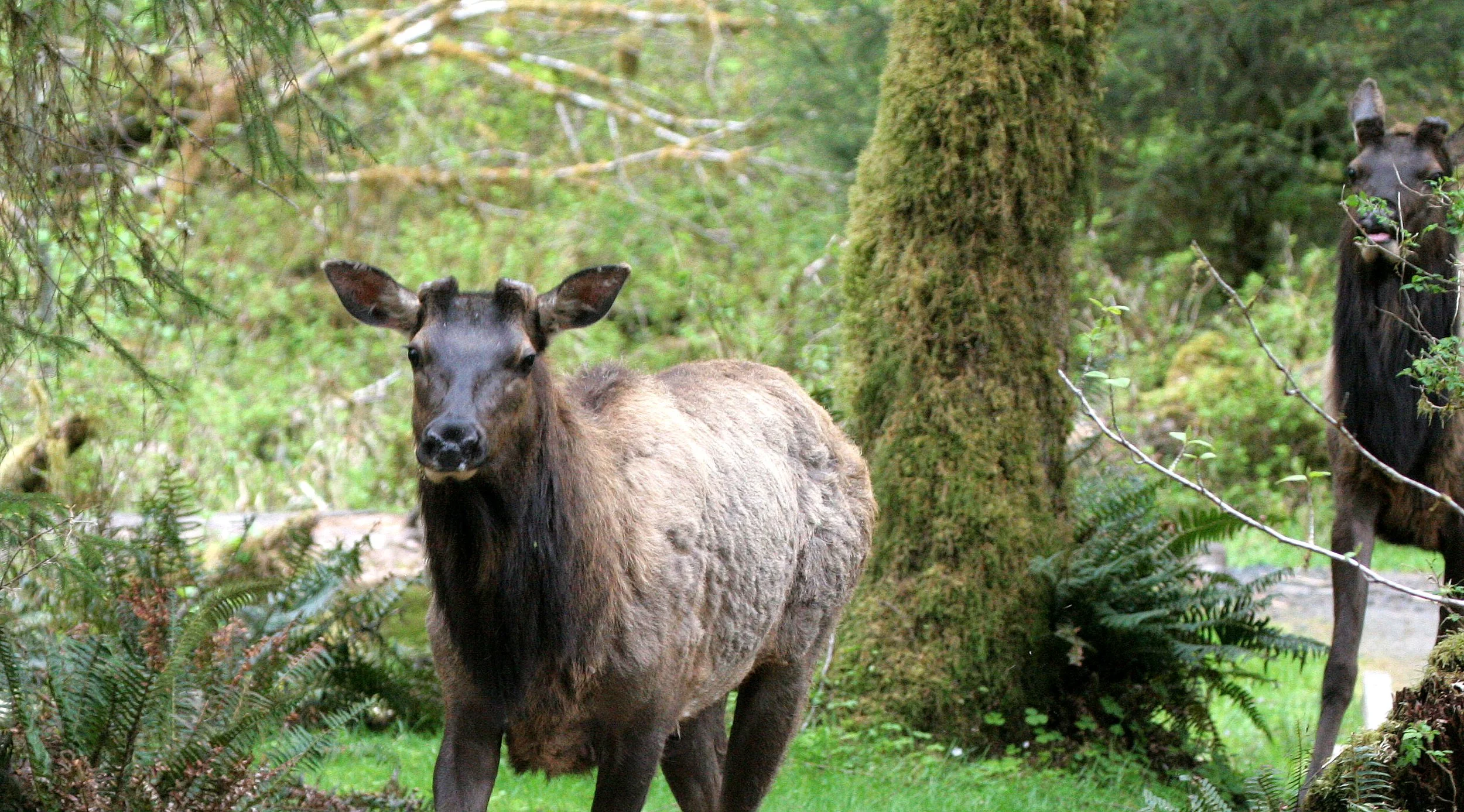





Rocky Mountain elk (Cervus canadensis nelsoni)
The Rocky Mountain elk (Cervus canadensis nelsoni) is a subspecies of elk found in the Rocky Mountains and adjacent ranges of Western North America.
The winter ranges are most common in open forests and floodplain marshes in the lower elevations. In the summer it migrates to the subalpine forests and alpine basins. Elk have a diverse habitat range that they can reside in but are most often found in forest and forest edge habitat and in mountain regions they often stay in higher elevations during warmer months and migrate down lower in the winter. They may even come down the mountain and leave the forest into some grassland for part of the day but head back into the timber in the evening.
Effects of climate change: Climate change/warming can keep elk in their higher elevation habitats for longer into the winter than normal. Climate changes such as warming have in some cases even increased the seasonal range of elk in the winter. For example, in Yellowstone the climate warming has kept the snow at a lower level than in the past and has given the elk the ability to populate higher ranges than before. The lack of snow in Yellowstone has also given the elk an advantage over the wolves in their predator prey relationship because wolves rely on deep snow to hunt elk in winter ranges of Yellowstone. The total wild population is about one million individuals.
Colorado The Rocky Mountain elk was reintroduced in 1913 to Colorado from Wyoming after the near extinction of the regional herds. While overhunting is a significant contributing factor, the elk’s near extinction is mainly attributed to human encroachment and destruction of their natural habitats and migratory corridors. A year later, twenty-one elk from Jackson Hole, Wyoming were reintroduced to South Dakota's Wind Cave National Park for population increase. Conservation efforts also brought the elk populations in New Mexico from near-zero numbers in the late 1800s and early 1900s, to healthy populations in the 1930s in Northern New Mexico.
Nebraska Population numbers of elk in Nebraska continued to increase through the 1970s and 1980s, to a level in which complaints from landowners in the Pine Ridge region led to the implementation of relatively liberal hunting seasons in the late 1980s. Elk numbers continued to increase through the 1990s to the present.
Washington All Rocky Mountain elk in Washington are the result of reintroductions conducted in the early 1900s from Yellowstone elk herds. These initial reintroductions have expanded their range and have also been translocated within the State. Not all of these elk have all the habitat to be successful in large numbers; supplemental feeding programs are used to compensate for lost winter range .
Eastern U.S. In 1990, feasibility studies were conducted to determine if wild, free-ranging elk still had a place in some of their former eastern habitats. Once this was complete, healthy source herds of Rocky Mountain elk from Arizona, Kansas, New Mexico, North Dakota, Oregon, and Utah were used to introduce this elk subspecies to the former range of the extinct eastern elk.
Kentucky In recent years, elk from Utah have been used to reestablish a population in Kentucky.
West Virginia In 2018, elk from Arizona were transported to West Virginia to help with reestablishing the population there. Unfortunately, a parasite has killed off some of the herd.
Canada Their populated Canadian ranges occur in Alberta's Jasper and Banff National Parks as well as British Columbia's Kootenay and Yoho National Parks.
Rocky Mountain Elk (Cervus canadensis nelsoni) - Rocky Mountains National Park, Colorado, Yellowstone, Wyoming









































Tule Elk (Cervus canadensis nannodes)
The Tule Elk (Cervus canadensis nannodes) is a subspecies of elk found only in California, ranging from the grasslands and marshlands of the Central Valley to the grassy hills on the coast.[2] The subspecies name derives from the tule (/ˈtuːliː/), a species of sedge native to freshwater marshes on which the Tule elk feeds. When the Europeans first arrived, an estimated 500,000 tule elk roamed these regions, but by 1870 they were thought to be extirpated.[2] However, in 1874–1875 a single breeding pair was discovered in the tule marshes of Buena Vista Lake in the southern San Joaquin Valley.[3] Conservation measures were taken to protect the species in the 1970s.
Tule Elk in Point Reyes, California.
Today, the wild population exceeds 4,000. Tule elk can reliably be found in Carrizo Plain National Monument, Point Reyes National Seashore, portions of the Owens Valley from Lone Pine to Bishop, on Coyote Ridge in Santa Clara Valley, San Jose, California and in Pacheco State Park and areas surrounding San Luis Reservoir near Los Banos, California. McCullough identified nineteenth century tule elk antler specimens collected in three separate locations north of the San Francisco Bay: Sonoma in Sonoma County, as well as San Geronimo and Tomales both in Marin County.
By 1986 numbers had increased to over 2,000 individuals distributed among 22 populations throughout California, largely due to successful reintroduction programs.[3] By 1998, California's tule elk population exceeded 3,200. In 2007, the statewide population was estimated at 3,800. A 2014 report placed the statewide population at 4,200 in 22 herds. As of 2019, the total Californian population was estimated to be 5,700.
Small numbers of tule elk in Point Reyes have tested positive for Mycobacterium avium subspecies paratuberculosis or "MAP", a wasting disease known as Johne's Disease. The bacteria was apparently transmitted by dairy cattle or spraying of cattle manure on pasturelands. In 2016 more tule elk tested positive after being euthanized so that their gut tissue could be analyzed. Cattle transmitted the disease to the Tomales Point elk herd shortly after they were first established there in 1978.
Tule Elk (Cervus canadensis nannodes) - Point Reyes and Kern County California









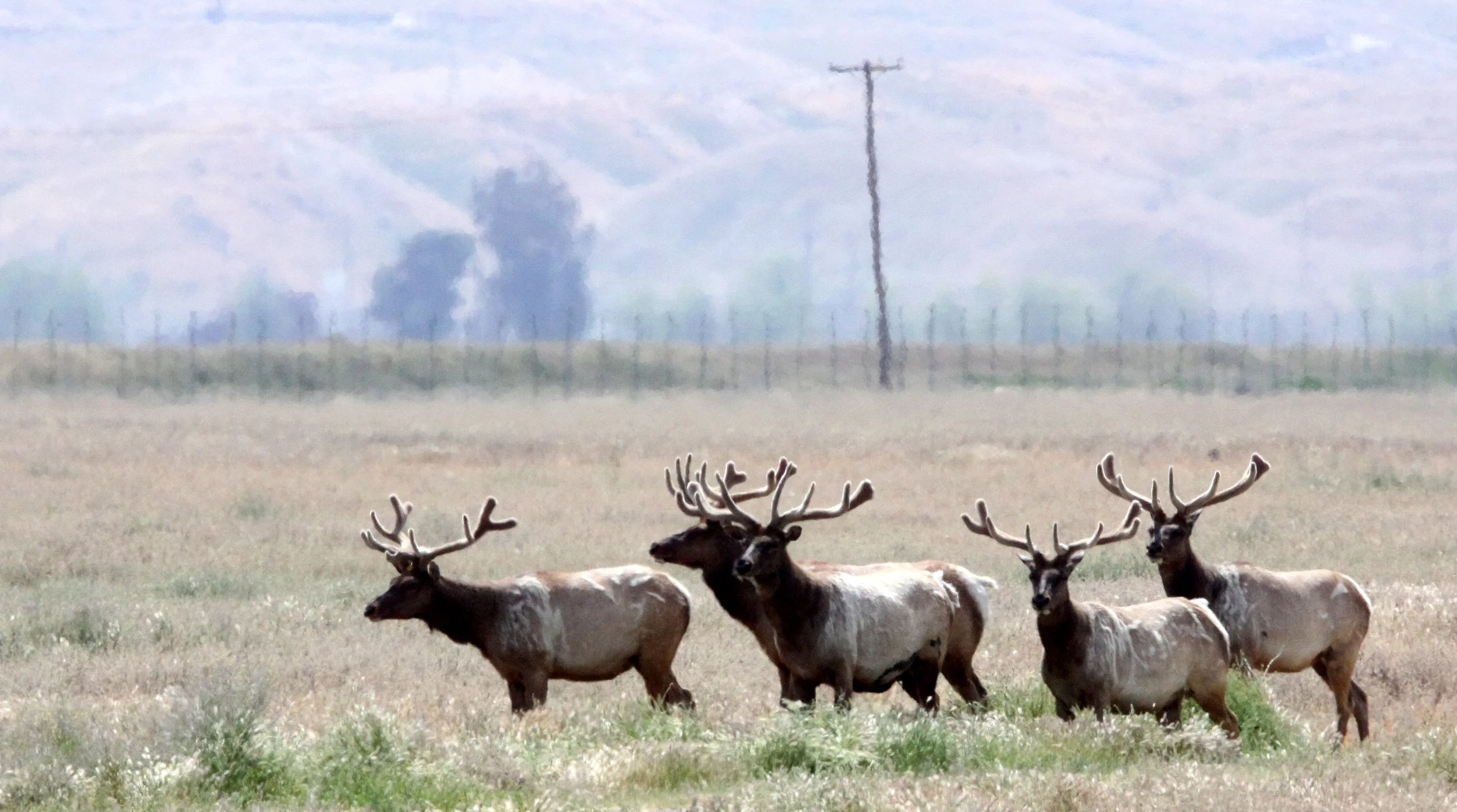




























Thorold's or White-lipped Deer (Cervus albirostris)
Thorold's deer (Cervus albirostris) is a threatened species of deer found in grassland, shrubland, and forest at high altitudes in the eastern Tibetan Plateau. It is also known as the white-lipped deer (Baichunlu, 白唇鹿, in Simplified Chinese, ཤྭ་བ་མཆུ་དཀར།་ in Standard Tibetan) for the white patches around its muzzle.
Thorold’s Deer resting on a hillside in Ke Ke Xi Li, Tibetan Plateau, China
This deer fills an ecological niche similar to the Tibetan red deer (shou, the subspecies wallichi of the red deer species group). It was first scientifically described by Nikolai Przhevalsky in 1883. As of early 2011, more than 100 Thorold's deer are kept in Species360-registered zoos, and in 1998 it was estimated that about 7000 remain in the wild.
Thorold's deer has traditionally been included in the genus Cervus, and genetic evidence suggests this is more appropriate than its erstwhile placement in the monotypic genus Przewalskium.
Thorold's deer is one of the largest deer species, with a shoulder height around 115 to 140 cm (45 to 55 in). Males, which typically weigh from 180 to 230 kg (400 to 510 lb), are significantly larger than females, at 90 to 160 kg (200 to 350 lb) in weight. The hair is coarse and grey-brown over most of the body, fading to yellowish buff on the underparts, with a distinct reddish-brown patch on the rump, and a ridge of darker hair running down the spine. During winter, the coat is paler, and about twice as thick as during the summer, being thicker even that of a moose. The head is darker than the rest of the body, especially in males, and contrasts with pure white markings on the lips, around the nose, and the throat just below the chin.
Adult male Thorold's deer have antlers, measuring up to 110 cm (43 in) in beam length, and weighing up to 4 kg (8.8 lb). Compared with those of wapiti or red deer, the antlers are flattened with the first and second ("bez") tines noticeably far apart. The antlers can have up to seven tines, which all lie in the same plane. They are shed annually in March, reaching their full length by late summer. Other distinctive features include longer ears than most other deer, lined with white hair, and large metatarsal and preorbital glands. The hooves are broad and heavy, with unusually long dewclaws. The tail is short, at 12 to 13 cm (4.7 to 5.1 in) in length.
Thorold's deer has a number of physical and physiological adaptations to its high altitude environment. The short legs and broad hooves make it an agile climber, able to use steep mountainous terrain to escape predators. Their nasal cavities are unusually large, allowing them to breathe in rarified high altitude air, while the thick hair protects against the cold. The red blood cells in this species are smaller than average for similarly sized mammals, and are very numerous, both features that increase its ability to take up limited amounts of oxygen.
Thorold's deer inhabit the Chinese provinces of Tibet, Sichuan, Qinghai, Gansu, and far northwestern Yunnan. Today, they are found only in scattered populations across these regions, apparently being most numerous in eastern Sichuan. They prefer mosaics of grassland, shrubland, and forest, and are often seen above the treeline. It is found at elevations of 3,500 to 5,100 metres (11,500 to 16,700 ft), among the highest of any deer species along with the south american taruca, and migrates seasonally from high summer pastures to lower terrain in winter.
Thorold’s or White-lipped Deer (Cervus albirostris) - Seen in Ke Ke Xi Li National Reserve, Qinghai China















Barbary Stag (Cervus elaphus barbarus)
The Barbary stag (Cervus elaphus barbarus), also known as the Atlas deer or African elk, is a subspecies of the red deer that is native to North Africa. It is the only deer known to be native to Africa, aside from Megaceroides algericus, which went extinct approximately 6,000 years ago.
The Barbary stag is smaller than the typical red deer. Its body is dark brown with some white spots on its flanks and back. The antlers lack the bez (second) tine.
The Barbary stag is the only member of the deer family that is native to Africa. It thrives in dense, humid forested areas of Algeria, Tunisia and Morocco.[3] It had initially been hunted to extinction in the latter, but specimens from the Tunisian population were reintroduced in the 1990s. One population can be found in Tazekka National Park in the Middle Atlas Mountains.
Barbary Stag or Atlas Deer (Cervus elaphus barbarus) - Seen in Tunisia and is the only native cervid in Africa











Common Red Deer (Cervus elaphus)
The Common Red Deer (Cervus elaphus) is one of the largest deer species. A male red deer is called a stag or hart, and a female is called a hind. The red deer inhabits most of Europe, the Caucasus Mountains region, Anatolia, Iran, and parts of western Asia. It also inhabits the Atlas Mountains of Northern Africa; its early ancestors are thought to have crossed over to Morocco, then to Algeria, Libya and Tunisia via the Strait of Gibraltar, becoming the only species of true deer (Cervidae) to inhabit Africa. Red deer have been introduced to other areas, including Australia, New Zealand, the United States, Canada, Peru, Uruguay, Chile and Argentina. In many parts of the world, the meat (venison) from red deer is used as a food source.
Red deer are ruminants, characterized by a four-chambered stomach. Genetic evidence indicates that the red deer, as traditionally defined, is a species group, rather than a single species, though exactly how many species the group includes remains disputed. The closely related and slightly larger American elk, or wapiti, native to North America and northeastern Asia, had been regarded as a subspecies of red deer, but recently it has been established as a distinct species. The ancestor of all red deer (and wapiti) probably originated in central Asia and resembled sika deer. Additional genetic research has suggested that the closest living species to the red deer is the fallow deer, Dama dama.
Although at one time red deer were rare in parts of Europe, they were never close to extinction. Reintroduction and conservation efforts, such as in the United Kingdom and Portugal, have resulted in an increase of red deer populations, while other areas, such as North Africa, have continued to show a population decline.
Central European or Common Red Deer (Cervus elaphus hippelaphus) - seen in Abruzzo National Park, Central Italy








Tibetan Red Deer (Cervus canadensis wallichi)
The Tibetan Red Deer (Cervus canadensis wallichi) also known as shou, is a subspecies of elk/wapiti native to the southern Tibetan highlands and Bhutan. Once believed to be near-extinct, its population has increased to over 8,300, the majority of which live in a 120,000-hectare nature reserve established in 1993 in Riwoqê County, Qamdo Prefecture, Tibet Autonomous Region, China. Some have been kept at the beginning of the 20th century in London, and in a small zoo south of Lhasa.
The Tibetan red deer is relatively massive built with short legs and a large, square muzzle. The winter fur is light sandy-brown, except the grayish face. The summer coat is slate-gray. The large, white rump patch, which includes the short tail, has no dark rim as it is seen in the Sichuan deer, for example. Those from the eastern part of the range have a dark dorsal line and represent probably the C. c. affinis type, which is now usually included in the shou.
Tibetan red deer, along with Sichuan deer and Kansu red deer, forms the southern group of wapiti. It lives in northern Bhutan and southern Tibet, where it is recorded from the Chumbi Valley close to Sikkim and from Lake Manasarovar. It was believed to be completely extinct until a small population was rediscovered in 1988 in Bhutan and southeastern Tibet. The original range probably covered many smaller valleys of the Brahmaputra River to the north of the Himalaya (Yarlung Tsangpo River). A survey in 1995 brought the exciting finding, that a population of about 200 Tibetan red deer still persists to the north of the Yarlung Tsangpo River close to the village of Zhenqi. As this is the only known viable population of this deer, it is planned to establish a reserve for protection here. Evidence for some other relict populations has been found around the Subansiri River.
Tibetan red deer (Cervus canadensis wallichi) - Habituated individual seen in a remote temple in Qinghai near Qinghai Lake






Spanish Red Deer (Cervus elaphus hispanicus)
The Spanish Red Deer (Cervus elaphus hispanicus), is a subspecies of the red deer native to Spain. The Spanish red deer is a polygynous subspecies, which means the males have two or more mates; during mating season, males show a dark ventral area in their abdomen. The males usually defend the mating territories on the females' favored location.
Iberian Red Deer (Cervus elaphus hispanicus) - many seen in Andalucia Spain










































Sika Deer (Cervus nippon)
The Sika Deer (Cervus nippon), also known as the Northern spotted deer or the Japanese deer, is a species of deer native to much of East Asia and introduced to other parts of the world. Previously found from northern Vietnam in the south to the Russian Far East in the north, it is now uncommon except in Japan, where the species is overabundant.
Its name comes from shika (鹿), the Japanese word for "deer". In Japan, the species is known as the nihonjika (ニホンジカ (日本鹿), "Japan deer"). In Chinese, it is known as 梅花鹿; méihuālù; 'plum blossom deer'.
The sika deer is a member of the genus Cervus, a group of deer also known as the "true deer".[citation needed] Formerly, sika were grouped together in this genus with nine other species. Now, only the sika and red deer remain, the latter being divided into three separate species: European red deer, central Asian red deer, and American elk (though this remains controversial).
Recent DNA evidence indicates these deer are not as closely related as previously thought, resulting in the creation of new species and genera. The genera Rucervus, Rusa, and Przewalskium are where most of the former Cervus species now belong. The ancestor of all Cervus species probably originated in central Asia and resembled sika deer. All Cervus species can crossbreed and produce hybrids in areas where they coexist (for example, introduced sika hybridize with native red deer in the Scottish Highlands, where this is a serious threat to the gene pool of the red deer population).
Serious genetic pollution has occurred in many populations, especially in China, so the status of many subspecies remains unclear. The status of C. n. hortulorum is particularly uncertain and might in fact be of mixed origin, hence it is not listed here.
Images in the below four galleries come from wild and habituated herds in China, Russia and several places in Japan itself. Not the distribution map for the locations of very isolated populations in China (Fujian Province) and Russia (Lazovskly Zapovednik).
C. n. aplodontus, northern Honshu
C. n. grassianus, Shanxi, China
C. n. keramae, Kerama Islands of the Ryukyu Islands, Japan
C. n. kopschi, southern China
C. n. mandarinus, northern and northeastern China
C. n. mantchuricus, northeastern China, Korea, and Russian Far East
C. n. nippon, southern Honshu, Shikoku, and Kyushu[citation needed]
C. n. pseudaxis, northern Vietnam
C. n. pulchellus, Tsushima Island
C. n. sichuanicus, western China
C. n. sintikuensis, Taiwan[citation needed]
C. n. soloensis, Southern Philippines (anciently introduced to Jolo island; of unknown subspecies origin, probably extinct)[5]
C. n. taiouanus, Taiwan
C. n. yakushimae, Yakushima, Japan
C. n. yesoensis, Hokkaido, Japan
The sika deer is one of the few deer species that does not lose its spots upon reaching maturity. Spot patterns vary with region. The mainland subspecies have larger and more obvious spots, in contrast to the Taiwanese and Japanese subspecies, whose spots are nearly invisible. Many introduced populations are from Japan, so they also lack significant spots.
The color of the pelage ranges from mahogany to black, and white individuals are also known. During winter, the coat becomes darker and shaggier and the spots less prominent, and a mane forms on the back of the males' necks.[6] They are medium-sized herbivores, though they show notable size variation across their several subspecies and considerable sexual dimorphism, with males invariably much larger than females. They can vary from 50 to 110 cm (20 to 45 in) tall at the shoulder and from 95 to 180 cm (35 to 70 in) in head-and-body length. The tail measures about 7.5–13 cm (3–5 in) long.
The largest subspecies is the Manchurian sika deer (C. n. mantchuricus), in which males commonly weigh about 68–109 kg (150–240 lb) and females weigh 45–50 kg (100–110 lb), with large stags scaling up to 160 kg (350 lb), although there had been records of Yezo sika deer bulls weighing up to 170 or 200 kg (370 or 440 lb). On the other end of the size spectrum, in the Japanese sika deer (C. n. nippon), males weigh 40–70 kg (90–150 lb) and females weigh 30–40 kg (70–90 lb). All sikas are compact and dainty-legged, with short, trim, wedge-shaped heads and a boisterous disposition. When alarmed, they often display a distinctive flared rump, much like the American elk.
Southern Chinese Sika Deer (Cervus nippon kopschi) - Meihuashan in Fujian Province - Habituated free roaming herd





Manchurian Sika Deer (Cervus nippon mantchuricus) - Primorye Province in Lazovsky National Reserve wild herd


Japanese Sika Deer (Cervus nippon nippon) - Miyajima Shrine, Miyajima Island domesticated herd


















Hokkaido Sika Deer (Cervus nippon yesoensis) - Seen in many locations in the wild in Hokkaido





























































































